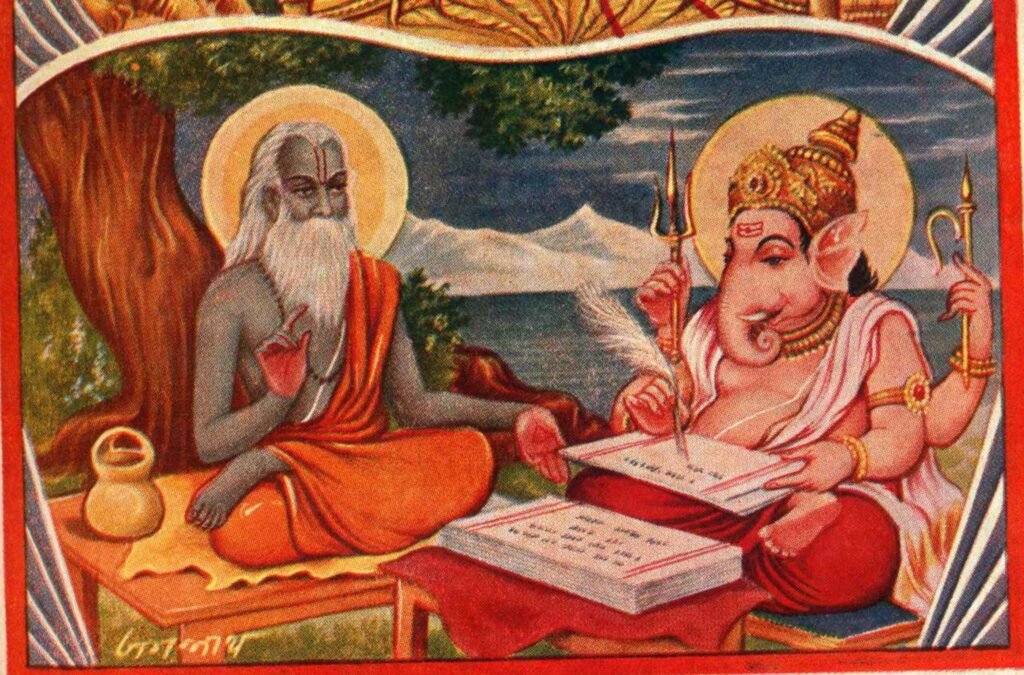Lord Ganesha Becomes Vyasa Muni’s Scribe

Note: After describing the origin story of the universe and the order in which various beings and devas come into existence, Sauti went on to tell the story of how Lord Ganesha became Vyasa Muni’s scribe to write the Mahabharata. These words were spoken by Sauti to the ascetics in Naimisha forest.
Rishi Vyasa has made this knowledge (the wisdom contained in his epic) available in both detailed and concise forms. The learned wish to possess both.
Some people read this composition (also referred to as a Purana by many) beginning with the initial mantra (invocation) while others begin with the story of Astika and yet others with the story of Uparichara. Some brahmanas study the whole from the beginning to the end. Learned people comment on the composition to display their knowledge. Some people are skillful in explaining it, while others are in remembering its contents.
Vyasa Muni, who was the son of Satyavati and Rishi Parashara, analyzed the eternal Veda through penance and deep meditation. Only after analyzing the Veda, did he compose this holy history – The (Maha)Bharata. However, Vyasa Muni was worried about how he would teach this new composition to his disciples.
Meanwhile, Lord Brahma (the all-knowing one and the world’s preceptor) understood Vyasa Muni’s dilemma and went to meet him in person. When Lord Brahma approached, Rishi Vyasa was seated with various tribes of holy people. Surprised to behold the great Lord, Rishi Vyasa immediately stood up, folded his palms, bowed to Lord Brahma, and had a seat brought for him. After Hiranyagarbha (another name for Brahma) took the seat, Vyasa Muni circumbulated him and stood next to him awaiting further instructions. When Lord Brahma asked the sage to take a seat, he sat down, full of affection and joy, next to Brahma’s seat.
The glorious Vyasa then addressed Brahma and said:
“O Divine Brahma, I have composed a poem that is studied by many learned people. I have explained several subjects in the poem, such as the mystery of the Veda, several rituals of the Upanishads, and the compilation of the Puranas.”
“I have named the three divisions of time: past, present, and future. I have explained the determination of the nature of decay, disease, existence, and non-existence.”
“I have described the beliefs and principles by which people live and their modes of life. I have described the rules for the four varnas and the importance of all the Puranas. I have given an account of asceticism and explained the duties of a religious student.”
“I have described the dimensions of the sun, the moon, other planets, the constellations, and the stars. I have explained the duration of the four ages.”
“I have spoken about the Rik, Sama, and Yujur Vedas. I have described adhyatma.”
“I have spoken about the sciences called nyaya, orthoepy, and treatment of diseases.”
“I have spoken about charity and pasupatadharma. I have spoken about celestial and human birth and their purpose.
“I have spoken about places of pilgrimage and other holy places along the rivers, mountains, forests, and the ocean. I have spoken about heavenly cities and the kalpas.”
“I have spoken about the art of war. I have described different kinds of nations and languages. I have described the nature of different types of people. I have spoken of the all-pervading spirit.”
Rishi Vyasa further addressed Lord Brahma and said, “I have mentioned all these topics in the poem, but I am unable to find a suitable person on earth to write this work.”
Brahma said. “I esteem you greatly for your knowledge of divine mysteries. I know your composition reveals the Divine word from its very first utterance, in a truthful language. Your composition, which you call a poem, shall remain unequaled by any other poet. O muni, think of Ganesa to help you with writing your composition.”
After giving this advice, Brahma returned to his abode and Vyasa Muni began to think of Lord Ganesha.
Ganesa, the destroyer of obstacles, was always ready to fulfill the desires of his followers. As soon as he realized that Vyasa Muni had thought of him, he himself went to the place Vyasa where was seated. After saluting Lord Ganesha and offering him a seat, Vyasa requested him to write the composition (Bharata) that he had formed in his imagination.
Ganesha answered: “I will write your composition provided my pen does not cease writing (due to pauses by Vyasa Muni).”
Vyasa Muni replied, “I agree, but you must stop writing if you come across a passage that you do not fully understand.”
Ganesa agreed by saying the word Om!
Vyasa began narrating the Bharata and he composed some passages in such a way that even Ganesha had to pause to fully comprehend their meaning. Thus, he narrated the entire (Maha)Bharat to Lord Ganesha who in turn wrote it for Vyasa.
Full Index: Table of Contents
Previous: Creation Story of the Universe as Explained in the Adi Parva
